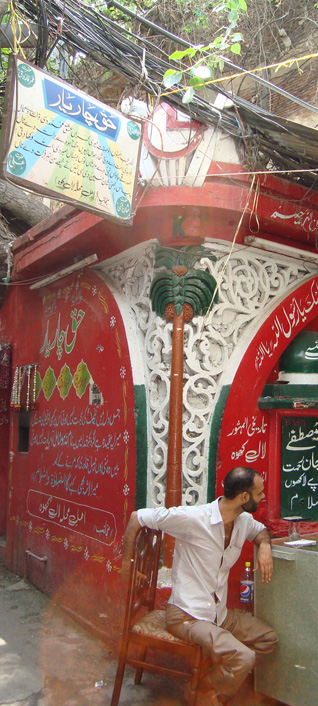History
Lahore, The Sikh City Of Tragedy And Triumph
HAROON KHALID
There is a small red structure inside the Mochi Gate of Lahore, one of the 13 historical gateways into the ancient walled city.
Painted red, the structure now hosts the shrine of Haq Char Yaar.
This shrine tells yet another tale of a place of worship belonging to another religion that was appropriated by the dominant Muslim population of the city after the Partition of Punjab and the creation of Pakistan.
I don’t know much about the history of the shrine, but the epithet ‘Haq Char Yaar’ refers to the “four friends” in Islamic Sunni iconography – the closest companions of Prophet Muhammad (Peace be upon him)), all of whom later became Caliphs – Abu Bakr, Umar, Uthman, and Ali.
Perhaps the clues to mystery of the origin of this shrine are contained within its name, which suggests that it does not belong to any one saint.
LAL KHOO - THE WELL OF BLOOD
Where this shrine stands today was once the site of a Sikh place of worship – Gurdwara Lal Khoo. The area within Mochi Gate retains the name Lal Khoo.
According to Sikh tradition, it was at this site that Guru Arjan, the Fifth Guru of Sikhism, was tortured before his martyrdom. The story goes that this site hosted the haveli, or mansion, of Chandu Shah, the Hindu agent of the Mughal Emperor, who had developed a hatred for the Guru and had engineered his arrest, torture and ultimate death. Ergo, the site of the torture was Chandu Shah’s own residence.
Sikhs believe that it was at the behest of Chandu, that the Mughal Emperor Jahangir, ordered the Guru’s assassination.
The Guru is believed to have spent his last days at this spot, occasionally washing and drinking from a well here – that’s how it came to be called Lal Khoo, the Well of Blood.
Guru Arjan’s martyrdom was a watershed in the history of Sikhism. It changed the course of this community, similar to what the assassination of Imaam Hussain did for Muslims.
It was under Guru Arjan that the Sikh identity began to be solidified, distinct from that of Hindus and Muslims. He began the compilation of what came to be known as the Guru Granth Sahib, giving the Sikhs their own, distinct Scripture. He also completed the Harmandar Sahib in Amritsar, the shrine within the ‘tank of nectar’ the construction of which was started by his father, around which the city of Amritsar developed, giving the Sikhs their equivalent of Jerusalem, Mecca and the Vatican.
Guru Arjan's martyrdom was in fact a pivotal turning point for the nascent Faith, which had only just begun strengthening its identity.
It was followed by a lot of introspection by the community, which feared continuing persecution. Taking on the mighty Mughal Empire headlong was out of the question. Should the Sikhs disavow all form of politics and emerge as a purely religious group?
This discussion was resolved by Guru Hargobind, the Sixth Guru. On the July 24, 1606, Guru Hargobind emerged in front of his followers, dressed as a royal, wearing a turban with an aigrette on it, a sword hung on each side. Each of these symbolic gestures was designed to challenge express edicts from the Mughal Emperor.
The Sixth Guru had taken the bold decision of militarizing the Sikh community so that it could fight oppression and also defend itself.
The institution of the Guru and Sikhism had entered a new chapter.
TWO ERAS
The samadh of Guru Arjan, a modest structure, is also located in the city, immediately outside, and facing, the Lahore Fort. Every year in June, thousands of Sikhs, from all over, converge at this shrine to commemorate the martyrdom of their Guru.
It is a sombre affair, without the grandeur and pomp of the Guru Nanak Gurpurab celebrations at the famous Nankana Sahib in Pakistan’s Punjab.
There is another event held in this complex at the end of June, this one to commemorate the death of Maharaja Ranjit Singh, the founder of the Sikh Empire, whose samadh stands next door to that of Guru Arjan, and in strong contrast to it.
While Guru Arjan’s samadh is a modest structure, that of Maharaja Ranjit Singh is a triple-storey, regal memorial, elaborately decorated with frescoes of Sikh iconography and subcontinental mythology.
Separated only by a few days on a calendar, the two events represent two iconic eras in Sikh history.
While the martyrdom of Guru Arjan in 1606 represents a turning point in Sikh history, a point when the community faced its first existential threat, its fortunes had turned by the time of the death of the Sikh Emperor in the year 1839.
From 1799, the year he took control of Lahore and made it his capital, up until 1839, Ranjit Singh was the undisputed Maharaja of the entire Punjab, whose borders also included areas to the west of the River Indus – an unprecedented tide of history, for millennia, invasions had hitherto always come into the subcontinent, from the west to the east. Ultimately, his suzerainty extended into Afghanistan, Kashmir, Ladakh and the Tibetan Himalayas, and arrested the British advance at the Sutlej.
Thus, under Ranjit Singh, the Sikhs had completed an entire cycle. The militarisation that began after the martyrdom of Guru Arjan, had now succeeded in stemming invasions from both the east and the west. The Sikh Empire of Punjab served as the last bastion of an independent kingdom in a subcontinent that was now otherwise completely dominated by the British.
The Sikhs had earned themselves the title of a martial race by the time British took over Punjab after the death of Ranjit Singh. They were no longer a minor group, as during Jehangir’s reign.
The British knew that if they wanted to keep their empire intact, they would need the support of the Sikhs, which is what saved them during the mutiny of 1857, against a rag-tag band of disgruntled troops egged on by the vested interests petty fiefdoms.
Haroon Khalid is the author of the books “In Search of Shiva: A study of folk religious practices in Pakistan”, and “A White Trail: A journey into the heart of Pakistan’s religious minorities”.
[Courtesy: Scroll. Edited for sikhchic.com]
June 11, 2016
Conversation about this article
1: Sangat Singh (Kuala Lumpur, Malaysia), June 11, 2016, 2:59 PM.
What a scholarly write-up in the climate of a rising tide of extremism in Pakistan as well in India. I am saving this site as well, in order to remember and read whatever Haroon Khalid writes.
2: Hardev Singh (Richmond Hill, Ontario, Canada), June 12, 2016, 10:32 PM.
Today I learnt some more facts of my history. Thank you, Khalid Sahib.
3: Prithipal Singh (Malaysia), June 14, 2016, 10:11 AM.
Thank you for sharing this article. Having visited the site - I was surprised by how little of the true history, if any, is documented at these sites. It is only from word of mouth of the local granthi - if there is one around in a gurdwara, which also if there is one around - did we learn about its historical significance.



